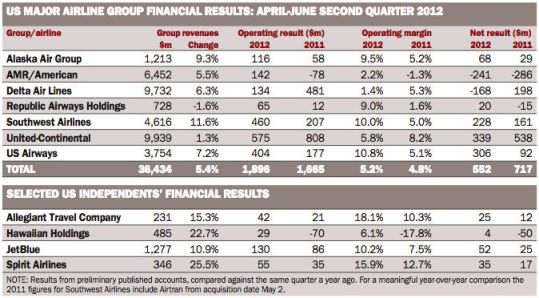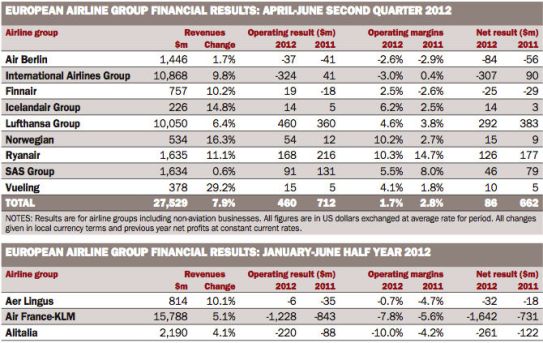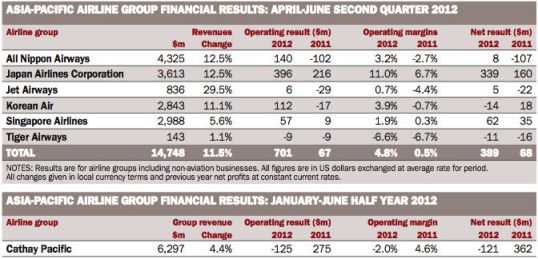While financial fortunes differed across the regions in the second quarter of the calendar year, the pain of fuel volatility was a constant for all. Even though oil prices in the second quarter relented from the prolonged highs of the previous 18 months, increased fuel costs - or hedging-related losses - were commonplace in airline accounts for the period.
Fuel also continues to cast a shadow over the full-year outlook for airlines. Much of the recent fall in oil prices has already been lost as the barrel price of crude oil has crept back up, while hedging limits the immediate respite for carriers from lower oil prices.
NORTH AMERICAN AIRLINES |
|---|
Despite the high fuel burden, carriers in North America continued to sustain their improved financial performance. Second-quarter operating profits for the US majors increased to a combined figure of almost $1.9 billion off the back of a 5% jump in revenues (see table). US independent operators also turned in improved profit figures for the quarter.
 |
|---|
"When we were moving through the second quarter, we saw some of the best revenue performance we've ever seen for the month of May, but the biggest risk was where fuel was going," said Richard Anderson, chief executive of Delta Air Lines, during the airline's second-quarter earnings call. The airline reported a net loss of $168 million due to $754 million in one-time special charges during the quarter.
The SkyTeam carrier paid a $561 million mark-to-market fuel hedge adjustment during the quarter. Its average price of jet fuel was $3.95 per gallon with hedges, compared with $3.37 per gallon without the hedges. The airline has one of the largest hedge books in the region.
Special charges hit otherwise strong earnings at US majors American Airlines and United Airlines during the quarter. United saw net profits slip 37% to $339 million in part due to $137 million in integration-related costs and operational issues.
Chapter 11 restructuring American, meanwhile, posted a net loss of $241 million after incurring $336 million in special charges. This included $230 million in reorganisation costs.
However, the Oneworld carrier points to a strong sales picture - the airline grew revenues 5.5% to $6.5 billion during the second quarter. "Our revenue performance has topped the industry for several months, leading to our first second-quarter profit in five years excluding reorganisation and special items," says Tom Horton, chairman and chief executive of American's parent AMR.
American increased passenger revenue per available seat mile (PRASM) by 8.7% to 12.63 cents compared with the second quarter of 2011. PRASM also improved at other US majors in the quarter: Delta up 8.5%, United 3% higher and US Airways rising 5.8%.
Profits grew at North American low-cost and niche carriers for the period. Alaska Air, Allegiant, Hawaiian Airlines, JetBlue Airways, Southwest Airlines, Spirit Airlines and WestJet all reported small improvements in operating and net profits for the second quarter.
JetBlue for example doubled net profits to 2011 to $52 million on $1.3 billion in revenue "Our focused growth strategy in Boston and the Caribbean and Latin America is clearly paying off as we generated record revenues and improved operating margins," says chief executive Dave Barger, highlighting record second quarter profits for the airline.
A strong grip on capacity has been central to the improved recent financial performance by North American carriers, particularly among the US majors. And the region's carriers have adopted a more guarded approach to capacity going forward. While this is more of the same for mainline airlines, it also sees low-cost carriers and niche airlines adopting similar perspectives.
For example ultra low-cost carrier Spirit, which lifted capacity 16% during the second quarter, plans to slow down expansion in 2013 after launching dozens of new routes this year. "The majority of the new service through the front of next year has been announced," says Barry Biffle. chief marketing officer at Spirit. "Obviously there'd be more capacity in the back half of 2013, but again the majority of everything new that we're going to do has been announced."
Chief executive of Southwest Gary Kelly says the carrier aims to become "more tactical" with capacity growth. This year the carrier pushed back delivery of 30 Boeing 737s from 2013-2014 into 2017-2018, to keep capacity flat or slightly down in the next few years. This forms part of its efforts to hit its 15% return goal on invested capital. Allegiant, though, seemingly has few reservations on fuel prices or capacity growth. The Las Vegas-based operator is to begin acquiring Airbus A319s in 2013 which, it estimates, save about $10 per passenger in fuel and other expenses compared with its Boeing MD-80s on similar segments. It will lift capacity 26% through the fourth quarter and 20%-25% next year.
EUROPEAN AIRLINES |
|---|
There was little let-up in the pressure on European carriers in the second quarter of 2012 as the difficulties - notably the sovereign debt crisis and high fuel prices - continue to take a heavy toll on profits. Combined figures for selected European carriers for the quarter show them barely scraping into profit at net level (see table).
 |
|---|
While the second quarter offered some respite at an operating level for Air France-KLM and Lufthansa, operating losses made by the legacy carriers at the halfway mark make grim reading. IAG lost €253 million ($311 million) in the first half, Lufthansa €20 million and, worst of all, Air France-KLM posted an eye-watering loss of €945 million. While the legacy carriers, most dependent on falling business traffic, were expected to struggle, the relatively resilient low-cost sector also felt the pressure. Ryanair reported a first-quarter year-on-year drop in profit of 29% to €99 million.
The pain from fuel costs was felt across the industry, made worse by the euro-dollar exchange rate. Peter Morris, chief economist of Flightglobal's data and consultancy division Ascend, says: "Three or four years ago, the euro-based economies were insulated against dollar-priced oil because of the devaluation of the dollar against the euro, but now it's working the other way."
IAG, for instance, saw fuel costs rise by 25% to €2.9 billion for the half-year against the same period last year. But IAG's issues run much deeper than fuel prices, says CTAIRA's head of consultancy Chris Tarry. While British Airways recorded an operating profit, after exceptional items, of €13 million in the period, Iberia made an operating loss of €263 million. The Spanish flag carrier is struggling against the country's economic headwinds, rising airport operating charges and "deep and structural" problems, says chief executive Willie Walsh.
Tarry says: "When you look at Iberia, you are in an economy which is in a shocking state and you have an airline which needs to be significantly smaller than it is."
The airline's recent performance means its restructuring must go deeper than originally foreseen, but Tarry feels there are also issues to be addressed at group level. "From the point of view of merger economics there has been no tangible or discernible benefit from the merger of BA and Iberia. We've talked about recognising synergies, but from the outside you can't see that," he says.
Air France-KLM is going through the pain of its own restructuring and booked a one-off provision of €368 million in second-quarter results to cover voluntary redundancies at Air France. There may be worse to come as it battles the unions to reshape its short- and medium-haul business. Losses on fuel hedging - caused by a 6% fuel price fall during the quarter - did not help, adding another €372 million of losses to its balance sheet.
Ryanair also felt the fuel pain. It recorded a year-on-year increase in fuel expenditure of €117 million in its first quarter to €544 million. Its average fuel price grew by 21% year-on-year.
But with the entire sector subject to higher cost bases than in 2011 and weaker holiday travel, Morris says Ryanair's results cannot be branded disappointing. He says that in such a climate "the core fundamental is that you have got your nose above the water".
At Lufthansa Group it was a familiar story. It generated an operating loss of €20 million during the first six months of 2012 against a €114 million operating profit during the same period last year. However, the company's net loss was cut from €206 million in H1 2011 to €168 million this half. Revenue increased 6% to €14.5 billion but profitability came under pressure from increased fuel costs, "sustained" price pressure, air passenger taxes in Germany and Austria, and the EU's Emissions Trading System, the airline says.
But some European operators were able to improve profits in the quarter. Spanish low-cost operator Vueling more than doubled its profits for the period to €7.7 million after boosting capacity by 21% aided by the demise of rival Spanair earlier this year.
Budget operator Norwegian grew net profit 69% to NKr90.5 million ($15.2 million). Based outside the eurozone, the Scandinavian carrier enjoyed a 1% year-on-year decline in average dollar spot prices for jet fuel in the second quarter, but a fuel hedging loss of NKr13 million contributed to higher per-tonne expenses.
And in Ireland, Aer Lingus - once more embroiled in a takeover battle with Ryanair - pointed to a strong performance in higher yielding and long-haul traffic as key to it cutting operating losses to €4.4 million in the first half. It marks an improvement on the €26.8 million lost at the same stage last year. "Most of the improvement has been on the revenue side," says the Irish carrier, pointing to a 10% jump in first-half revenues to €626 million.
ASIA-PACIFIC AIRLINES |
|---|
Asia-Pacific operators enjoyed improved fortunes in the three months to June 2012. All Nippon Airways and Japan Airlines both recorded improved results for the second quarter compared with the corresponding period last year - which was impacted by the devastating earthquake in Tokyo. They helped contribute to collective operating profits of $700 million for selected Asian operators in the second quarter - compared with $67 million at the same stage last year (see table).
 |
|---|
Asian carriers have not escaped fallout from Europe's economic woes, exposure to the sluggish air cargo market and higher fuel costs, but the region remains one of dynamic growth. One market which continues to struggle to deliver on undoubted potential is India, but the second quarter brought signs the tide is turning for Indian carriers Jet Airways and SpiceJet. After posting five consecutive quarters of losses, both have returned to profitability. Their positive results were unexpected as Indian carriers have been struggling to stay afloat in a turbulent operating environment plagued by high taxes, excess capacity and high operating costs.
Low-cost carrier SpiceJet posted Rs562 million ($10.1 million) in net profits for the period ending 30 June, a drastic swing from the net loss of Rs720 million it incurred a year earlier. Meanwhile, Jet Airways managed a net profit of Rs247 million for the quarter, reversing its loss of Rs1.23 billion in FY2012. Its low-cost subsidiary JetLite also reaped a net profit of Rs117 million.
Both carriers attributed stringent cost cutting, yield improvements and a surge in demand for their positive results. SpiceJet was able to grow its passenger traffic by 24%, while domestic and international passenger numbers for Jet Airways rose 10% and 20%.
The carriers partly have ailing Kingfisher Airlines, which has been operating on a skeletal fleet of 20 aircraft on 120 daily flights, to thank. Kingfisher and flag carrier Air India had to cancel flights several times during the quarter as pilots and staff went on strikes to protest against issues, including non-payment of salaries. With less seats in the market, SpiceJet and Jet Airways have been able to bring in new passengers and raise fares, improving yields.
Cash-strapped Kingfisher remains under pressure. Its net loss for its fiscal first quarter more than doubled to Rs6.5 billion this year, from Rs2.6 billion a year ago. This is despite having received Rs7.5 billion from parent company UB Group to aid its cash flow. As part of deep restructuring efforts, the beleagured carrier suspended all international services and reduced domestic operations in March. It now has the smallest market share among Indian carriers.
Kingfisher now hopes for a rule change to get foreign investors to pump money into the airline, giving it a new lease of life. It comes as the Indian government is said to be close to liberalising its foreign ownership policy to allow international airlines to buy up to a 49% stake in domestic carriers.
Besides high fuel costs, tax rates and the depreciation of the Indian rupee, Kingfisher adds that expenses and costs incurred from returning aircraft to lessors and not operating a full fleet also added to its losses. It revealed that several lessors, concerned with its defaults in payments, terminated lease agreements during the quarter. It also had to compensate several parties when it terminated agreements to cut costs.
"The company has incurred substantial losses and its net worth has been eroded," it says. But the carrier, owned by liquor tycoon Vijay Mallya, maintains it will get fresh funds. "Kingfisher continues to believe it will get recapitalised and get on a path of sustained profitability. The airline is in discussions with several strategic and financial investors to bring in fresh capital," it says.
Meanwhile, Jet Airways says it expects yields to stay strong in the next quarter with capacity growth in the industry expected to grow less than 5% for the year. To cut costs, it will also suspend services on non-profitable routes.
SpiceJet's chief executive Neil Mills wants the government to step in. His main concerns are "excessive taxation" on jet fuel, weakening of the Indian rupee, and a sharp increase in airport charges. "The need of the hour is for the government of India to intervene proactively and launch initiatives urgently to improve the health of Indian civil aviation," says Mills.
Source: Air Transport Intelligence news



















